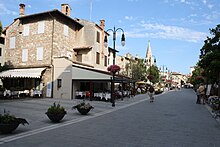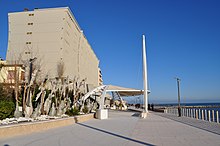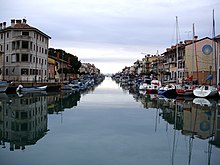Grado (Friuli Venezia Giulia)
| Grado | ||
|---|---|---|

|
|
|
| Country | Italy | |
| region | Friuli Venezia Giulia | |
| Coordinates | 45 ° 41 ′ N , 13 ° 24 ′ E | |
| height | 2 m slm | |
| surface | 114 km² | |
| Residents | 8,054 (Dec. 31, 2019) | |
| Population density | 71 inhabitants / km² | |
| Post Code | 34073 | |
| prefix | 0431 | |
| ISTAT number | 031009 | |
| Popular name | Gradesi | |
| Patron saint | Santi Ermacora e Fortunato (July 12th) | |
| Website | Grado | |
The city of Grado (from the Latin ad gradus, "on the step", i.e. a canal that led to Aquileia ; Furlanian Gray, Gradian Gravo, Slovene Gradež ) with 8054 inhabitants (as of December 31, 2019) is located on the north coast of the Adriatic Sea on a coastal dune at the far end of the Gulf of Venice . The island of Grado is also called the island of the sun or the island of gold .
geography
The island of Grado is connected to the mainland in the north by a four-kilometer-long causeway and in the north-east by a road bridge of Via Monfalcone over the Canale Primero .
In addition to the island, Grado is also the namesake of the lagoon surrounding it . The 12,000 hectare Laguna di Grado is located east of the Laguna di Marano. The temperature of the lagoon averages 13.6 ° C, the humidity approx. 76.8%.
The flora and fauna are very lush; over 150 different bird species are at home here alone. Many migratory birds rest in the lagoon in spring and autumn. The variety of different types of mussels and fish is also great. For example, the Capa Tonda and the clam live here, as well as various types of shrimp , sole and perch .
One of the largest of the several hundred islands in the lagoon is called Barbana (since 582 AD). On Barbana stands the pilgrimage church with the statue of the Madonna and Child, to which the fishermen of Grado organize a pilgrimage every year on the first Sunday in July , the so-called Perdon de Barbana .
There are restaurants on several islands in the lagoon, many of the smaller islands are privately owned. On top of these are the so-called casoni, small thatched-roof houses in which mainly fishermen live temporarily. Some of the casoni are used by the owners as weekend houses .
history

Grado was probably founded in the 2nd century BC. It was founded as a sea port for the city of Aquileia and was named Ad Aquas Gradatas. The military port was under the Roman fleet base Classis in Ravenna . A castrum was laid out after the Marcomanni storm (around 180 AD) . There was a year-round trade between Aquileia and Ravenna, which was carried out via the lagoon chain of Grado, Marano, Caorle, Venice and Comacchio.
From the 4th century the first Christian churches were built in Grado: Sant'Eufemia , Santa Maria delle Grazie and the church in Piazza Biagio Marin. The Cathedral of Sant'Eufemia was built in 456 under the rule of the Patriarch Nicetas of Aquileia . After the attack by the Huns, led by Attila in 452, Grado temporarily became the seat of the archbishop . Accordingly, from the middle of the 5th century there is no evidence of settlements in the lagoon, but it has been shown that Aquileia did indeed continue to exist. After the fall of the Roman Empire , Grado was part of the Byzantine Venice . After 568 the archbishop and later patriarch chose Grado as the final seat, which was transferred to San Silvestro in Venice in the 12th century .
Between 575 and 1131, Grado had its own patriarchs, until the Patriarchate of Venice was founded (see Patriarchate of Grado ). For several centuries Grado was attacked and plundered by pirates and neighbors, but the early Christian churches of Sant'Eufemia, Santa Maria delle Grazie and the Baptistery of San Giovanni Battista were preserved as most valuable treasures.
The Comes, who lived in Grado, had the task of enforcing the so-called stacking requirement in the Gulf of Venice (e.g. the Ancona - Pula line ), i.e. the stipulation that every trader in Venice had to offer his goods for sale on the local marketplace as soon as he had them Exceeded stack area limits. For this purpose, the Comes of Grado had small ship associations around the Gulf. The rule of the Republic of Venice over Grado lasted from the late Middle Ages to 1797. With the Peace of Campo Formio in 1797 and again from 1815, Grado belonged to the Habsburg Empire and from 1815 to the German Confederation .
In 1854, the first "camerini", ie. H. Changing and bathing cabins set up. In 1873 the lake hospital was built, which was also available to children of the poorer population. The Diga breakwater to protect the facilities was completed in 1885. In 1892, under Emperor Franz Joseph I, the "Kur- und Badeanstalt Grado" was founded by decree, and the fishing village was expanded to become the imperial and royal (kk) seaside resort of Grado. In 1896, the Fonzari was the first large hotel in town. Conditions for the expansion of the seaside resort were the construction of an artesian well for the drinking water supply in 1900 and the drainage of the 6.5 hectare area of Corbatto east of the old town in 1900/01. In 1903 the Viennese artist couple Emma and Josef Maria Auchentaller moved to Grado, where they built their Pension Fortino on the site of the Napoleonic fortifications demolished in 1902 and attracted the Viennese bourgeoisie with professional tourism marketing. In 1910, the Imperial and Royal Privileged Friulian Railway Company (FEG) established the connection to the railway line to Vienna with the Cervignano – Aquileia – Pontile route per Grado . With the outbreak of World War I , the time of the Austrian Riviera was over.
Until the end of the First World War, the municipality was part of the county of Gorizia and Gradisca , subordinate to the judicial district of Cervignano , which in turn was part of the district of Monfalcone .
In May 1915, after the strategic withdrawal of the k. u. k. -Toops occupied by Italy behind the Isonzo . After a brief reconquest in 1917, it was finally awarded to Italy in the peace negotiations of St. Germain (1919). Since then it has belonged to the province of Gorizia , which was dissolved in 2017. In the 1920s there was already a lively influx of tourists from Central Europe, which came to an abrupt end with the Second World War .
With the construction of the 5 km long causeway to the north in 1936, the road traffic island existence came to an end. The unprofitable railway line to Cervignano was closed in 1937. In 1966 the second bridge to the east was built. Today the inhabitants live mainly from sea fishing and tourism, which has flourished since the 1960s.
architecture
- Early medieval basilica of Sant'Eufemia
- Santa Maria delle Grazie church
- Baptistery of San Giovanni Battista
- Basilica della Corte, excavations of two early Christian churches in Piazza Biagio Marin
- Auditorium San Rocco, secularized church building from the 17th century that is used as a gallery in the summer season
- Barbana island and pilgrimage church
- Madonnina del Mare, statue in the lagoon north of the port
- Ville Bianchi, five hotel buildings built by Leonhard Bianchi around 1900
- The maritime museum Museo nazionale dell'archeologia subacquea dell'alto adriatico, for which the city of Grado made the property of the former school on the beach promenade available for 99 years in 1992, is still waiting to be opened (as of 2019).
Infrastructure and tourism
The main beach (Spiaggia Principale), Costa Azzurra beach and Pineta beach are connected by a promenade. The main beach is operated by Grado Impianti Turistichi (GIT for short) owned by the Friuli Venezia Giulia region and the city of Grado. Grado beaches have been awarded the Blue Flag eco-label since 2000 .
Parco della Rose is located parallel to the main beach . Various concerts, literature and dance events take place there in summer.
Grado is a spa town with a thermal bath and a spa center in the Città Giardino district .
The port of Porto Mandracchio in Grades is mainly used by fishermen. The eastern side of the harbor is reserved for the locals who have their sailing boats there, the western side is used exclusively by guest boats.
In Grado there are over 30 hotels, four campsites and around 50 restaurants and bars. The Gradeser Borèto , a fish soup, is a specialty . There are around 30 different types of boreto, and they contain different types of fish depending on the season. Vegetables are produced in the districts of Fossalon and Boscat.
In Grado there is a small rescue station for the fire brigade and ambulance as well as an ambulatory, a small emergency room. If the injuries are more severe, patients are taken to Monfalcone hospital.
With funds from the Italian government, the city center was converted into a pedestrian zone .
Sports
There is an 18-hole golf course and a tennis club. The local sailing club has settled in the harbor district near the fish wholesale market hall. In 2017 the first stage of the Giro d'Italia Femminile ended in Grado.
language
Grado is a variant of the Venetian speaking, the so-called Grado dialect .
Partner communities
Grado maintains partnerships with the Austrian communities Feistritz near Knittelfeld and Sankt Lorenzen near Knittelfeld . Although the partnership charter was only signed on November 29, 2003, the contact and friendship between the congregations dates back to 1989. Every year Feistritz and Sankt Lorenzen bring a Christmas tree to Grado, which decorates the Basilica of Sant'Eufemia at Christmas time. There are also joint events, for example concerts, with participants from both cities.
Personalities
sons and daughters of the town
- Biagio Marin (1891–1985), Italian poet
- Mario David (1934-2005), Italian football player
- Jacopo Marin (* 1984), Italian athlete
People closely related to the city
- Josef Maria Auchentaller and his wife Emma made a decisive contribution to the tourist boom in the Adriatic Sea.
See also
literature
- Giovanni Brusin: Small guide through Aquileia a. Grado. Third revised edition, Tipografia Antoniana, Padua 1955, pp. 1–111 with 66 illustrations (photos) and a plan of the excavation area at the Cathedral of Aquileia.
- Ezio Marocco: Grado. An art history travel guide. Bruno Fachin, Triest 2000. ISBN 88-85289-59-2 .
- Evelyn Rupperti: Grado. The near south in every season. Carinthia Verlag , 1st edition, 2007. ISBN 978-3853786178 .
- Andreas Schwarz, Martha Brinek: Gusto Grado. A search for traces between villas, history and cuisine. Amalthea, Vienna 2019. ISBN 978-3-99050-129-0
Web links
- Grado city website (Italian, English, German)
Individual evidence
- ↑ Statistiche demografiche ISTAT. Monthly population statistics of the Istituto Nazionale di Statistica , as of December 31 of 2019.
- ↑ Luisa Bertacchi: Ad Aquas Gradatas . In: Richard Stillwell et al. a. (Ed.): The Princeton Encyclopedia of Classical Sites. Princeton University Press, Princeton NJ 1976, ISBN 0-691-03542-3 . Jakob Weiss: Gradus. In: Paulys Realencyclopadie der classischen Antiquity Science (RE). Volume VII, 2, Stuttgart 1912, Col. 1690.
- ↑ Dario Gaddi: Approdi nella Laguna di Grado. In: Antichità Altoadriatiche. 2001. pp. 261-275 ( online , PDF).
- ↑ Manlio Lilli: Musei, il fantasma di quello dell'archeologia subacquea a Grado: dopo 25 anni è solo sul sito. In: ilfattoquotidiano.it. June 7, 2017. Retrieved October 26, 2019.
- ↑ Grado.info. ( Memento from June 3, 2015 in the Internet Archive ). Retrieved November 23, 2019.





